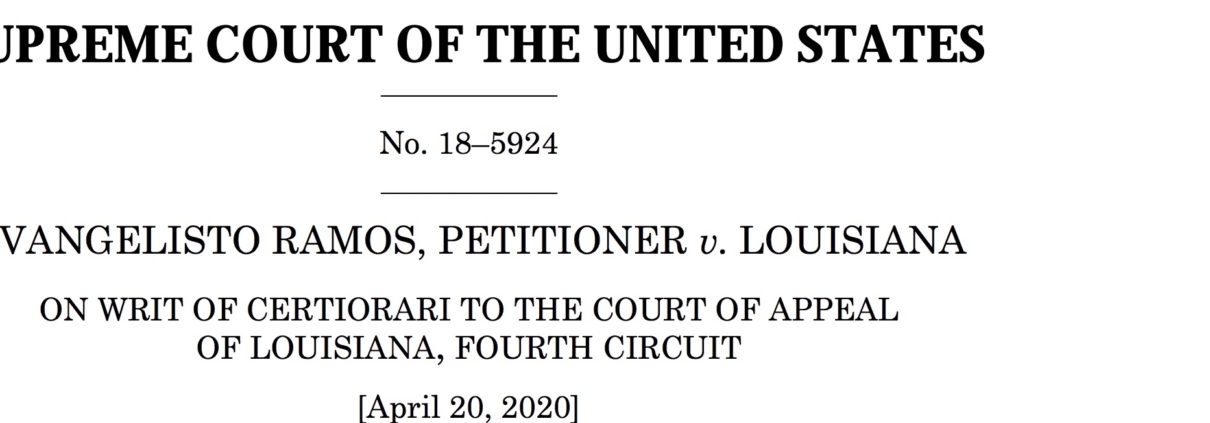 Great news out of the Supreme Court today. In Ramos v. Louisiana, the Supreme Court of the United States declared that non-unanimous juries, also known as split juries, are unconstitutional. However, the main question after Ramos is whether the decision is retroactive. Meaning, the question is – does the Court’s decision apply to cases that have already been decided/to people whose convictions have already become final under the law?
Great news out of the Supreme Court today. In Ramos v. Louisiana, the Supreme Court of the United States declared that non-unanimous juries, also known as split juries, are unconstitutional. However, the main question after Ramos is whether the decision is retroactive. Meaning, the question is – does the Court’s decision apply to cases that have already been decided/to people whose convictions have already become final under the law?
If the decision is not retroactive, then only those persons with a pending criminal case or a conviction that is still on direct appeal will receive the benefit. If the decision is retroactive, then anyone who was convicted by a non-unanimous jury will receive the benefit of Ramos v. Louisiana even if their case is in the post-conviction stage or has already lost a post-conviction petition.
The Teague Rule will determine if Ramos is retroactive.
The main case on this issue is Teague v. Lane, 489 U.S. 288 (1989). The primary thrust of this decision is that if the Supreme Court decides something after a person’s conviction and sentence become final, then the Supreme Court’s decision does not apply retroactively. This would include a Supreme Court decision declaring something unconstitutional.
However, Teague only applies to procedural rules and not to substantive rules. A procedural rule is a rule that only relates to the manner of determining whether or not someone is guilty. A substantive rule is a rule that alters the range of conduct or the class of persons that the law punishes.
Example of a Non-Retroactive Procedural Rule
An example of a procedural rule can be found in Schriro v. Summerlin, 542 U.S. 348 (2004). When the petitioner’s conviction and sentence became final, the Supreme Court had not yet ruled that any aggravating factors used in sentencing needed to be voted on by a jury. In the petitioner’s case, the trial court heard evidence, determined an aggravating factor existed, and applied the aggravating factor by itself. No jury voted on whether the aggravating factor should apply.
However, in the time that the petitioner was seeking relief, the Supreme Court said that aggravating factors needed to be decided by the jury. This means that it was unconstitutional for a trial judge to make that decision. The petitioner said that this rule should apply to his case and that his sentence should be thrown out because the trial court decided on its own to apply the aggravating factor.
The Supreme Court in Summerlin held that because the new rule only affected the determination of a person’s guilt, the rule was procedural. Therefore, it was not retroactive because it was a procedural rule.
Example of a Retroactive Substantive Rule
An example of a substantive rule is the rule in Lawrence v. Texas in which the Supreme Court held that it was unconstitutional to prosecute persons for homosexual sodomy. This new rule altered the range of conduct and class of persons for which a person could be prosecuted, so it was substantive and therefore, retroactive. (The rule in Miller v. Alabama–holding life sentences for juveniles only in extreme circumstances–was also held to be substantive in Montgomery v. Louisiana.)
At first glance then, it seems that the decision in Ramos v. Louisiana, striking down non-unanimous juries, is procedural because it solely relates to the manner in which a person is convicted. Therefore, it would not be retroactive.
Another Exception to Teague
However, there is another exception to the Teague rule for watershed rules of criminal procedure implicating the fundamental fairness and accuracy of the criminal proceeding. Saffle v. Parks, 494 U.S. 484, 495 (1990). To qualify, the rule must (1) relate to the accuracy of the conviction, and (2) change “our understanding of the ‘bedrock procedural elements’ essential to the fairness of a proceeding.” Sawyer v. Smith, 497 U.S. 227, 242 (1990).
Applying Teague to Ramos
There are two arguments in support of Ramos v. Louisiana being retroactive.
First, non-unanimous juries primarily impact Black persons and other persons of color. Therefore, any rule change has implications for an entire class of persons—categorically defined by race—for which they would not have been convicted but-for a non-unanimous jury. This could weigh in favor of arguing that a new rule is substantive and not merely procedural.
Second, and perhaps the stronger argument, is that a rule striking down non-unanimous juries is a “watershed rule of criminal procedure.” Obviously a non-unanimous jury affects the accuracy of a conviction. Moreover, the idea of a fundamentally fair proceeding would be impacted by a ruling stating that non-unanimous juries were unconstitutional.
We anticipate that we will hear within the next year about whether Ramos v. Louisiana is retroactive. When we hear additional news about this decision, we will provide an update.

